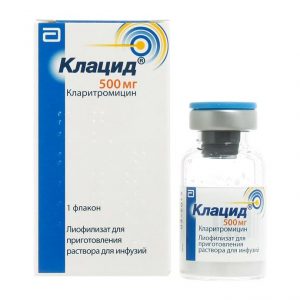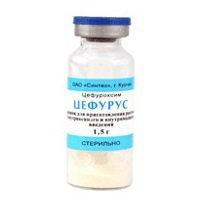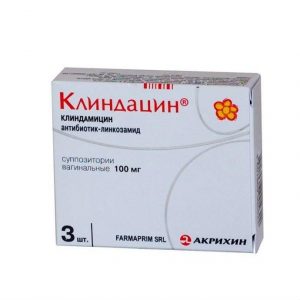Description
Release form
Powder for solution for infusion.
Packaging
1 bottle.
Pharmacological action
Cephalosporin III generation broad-spectrum antibiotic for parenteral administration. It acts bactericidal, inhibiting the synthesis of the bacterial cell wall. Acetylates membrane-bound transpeptidases, thus disrupting the crosslinking of peptidoglycans, necessary to ensure the strength and rigidity of the cell wall. Resistant to -Lactamases produced by most gram-positive and gram-negative bacteria.
Active against:
Gram-positive aerobic bacteria: Staphylococcus aureus.
Staphylococcus epidermidis.
Streptococcus pneumoniae.
Streptococcus pyogenes.
Streptococcus agalactiae.
Streptococcus viridans.
Streptococcus bovis.
Gram-negative aerobic bacteria
Aeromonas spp.
Alcaligenes spp.
Branhamella catarrhalis (including strains forming -lactamases)
Citrobacter spp.
Enterobacter spp. (some strains are resistant).
Escherichia coli.
Haemophilus ducreyi.
Haemophilus influenzae (including penicillinase producing strains).
Haemophilus parainfluenzae.
Klebsiella spp. (including Klebsiella pneumoniae).
Moraxella spp.
Morganella morganii.
Neisseria gonorrhoeae (including penicillinase producing strains).
Neisseria meningitidis.
Plesiomonas shigelloides.
Proteus mirabilis.
Proteus vulgaris.
Providencia spp.
Salmonella spp. (including Salmonella typhi).
Serratia spp. (including Serratia marsescens).
Shigella spp.
Vibrio spp. (including Vibrio cholerae).
Yersinia spp. (including Yersinia enterocolitica).
Pseudomonas aeruginosa (some strains).
Gram-negative anaerobic bacteria: Bacteroides spp. (including some strains of Bacteroides fragilis).
Clostridium spp. (except Clostridium difficile).
Fusobacterium spp. (except Fusobacterium mortiferum and Fusobacterium varium).
Peptococcus spp.
Peptostreptococcus spp.
Resistant to the drug: Methicillin-resistant strains of
Staphylococcus spp.
strains of Enterococcus spp. (Enterococcus faecalis).
Clostridium difficile.
Many strains of Bacteroides spp. (producing -lactamases).
Not hydrolyzed by R-plasmid -lactamases, as well as by the majority of chromosome-mediated penicillinases and cephalosporinases, can act on multiresistant strains tolerant to first-generation penicillins and cephalosporins and aminoglycosides. The acquired resistance of some strains is due to the production of -Lactamase inactivating ceftriaxone (ceftriaxonase).
Indications
Infectious and inflammatory diseases caused by microorganisms sensitive to ceftriaxone, including peritonitis, sepsis, meningitis, cholangitis, gallbladder empyema, shigellosis, salmonella carriage, pneumonia, lung abscess, pleural empyema, pyelonephritis, infections of bones, joints, skin and soft tissues, genital organs, infected wounds and burns.
Prevention of postoperative infection.
Contraindications
Hypersensitivity to ceftriaxone and other cephalosporins.
Use during pregnancy and lactation
Adequate and strictly controlled studies of the safety of ceftriaxone during pregnancy have not been conducted.
The use of ceftriaxone during pregnancy and lactation is possible in cases where the intended benefits of therapy for the mother outweigh the potential risk to the fetus.
Ceftriaxone is excreted in breast milk with low concentrations.
In experimental animal studies, no teratogenic and embryotoxic effects of ceftriaxone were found.
Special instructions
Allergic reactions to cephalosporin antibiotics are possible in patients with hypersensitivity to penicillins.
Use with caution in cases of severe renal impairment.
Ceftriaxone solutions should not be mixed or administered simultaneously with other antimicrobials or solutions.
In infants with hyperbilirubinemia, especially in premature infants, use under strict medical supervision is possible.
Composition
Ceftriaxone (in the form of sodium salt) 2 g.
Dosage and administration
Individual. Intravenously or intravenously, 1 2 g every 24 hours or 0.5 1 g every 12 hours are administered. Depending on the etiology of the disease, it may be administered once daily in a dose of 250 mg. The daily dose for newborns is 20-50 mg / kg for children aged 2 months to 12 years – 20-100 mg / kg, the frequency of administration is 1 time / day. The duration of the course is determined individually. In patients with impaired renal function, a correction of the dosage regimen is required taking into account QC values.
Maximum daily doses: for adults – 4 g, for children – 2 g.
Side effects of the digestive system: digestive system: nausea, vomiting, diarrhea, transient increase in hepatic transaminase activity, cholestatic jaundice, hepatitis, pseudomembranous colitis.
Allergic reactions: skin rash, itching, eosinophilia rarely – Quincke’s edema.
From the hemopoietic system: with prolonged use in high doses, changes in the picture of peripheral blood are possible (leukopenia, neutropenia, thrombocytopenia, hemolytic anemia).
From the blood coagulation system: hypoprothrombinemia.
From the urinary system: interstitial nephritis.
Effects due to chemotherapeutic effect: candidiasis.
Local reactions: phlebitis (with iv administration), pain at the injection site (with iv administration).
Drug Interactions
Ceftriaxone, by suppressing the intestinal flora, interferes with the synthesis of vitamin K. Therefore, when used together with drugs that reduce platelet aggregation (NSAIDs, salicylates, sulfinpyrazone), the risk of bleeding increases. For the same reason, with simultaneous use with anticoagulants, an increase in anticoagulant action is noted.
When used simultaneously with loop diuretics, the risk of developing nephrotoxicity increases.
Storage conditions
Keep dry, protected from light at a temperature of 15 ° to 25 ° C.
Expiration
3 years.
active substance
Ceftriaxone
lekarstvennaja form
Solution for and infusions
Prescribing
Children as prescribed by the doctor, Pregnant as prescribed by the doctor, Adults prescribed by a doctor
indications
indications From eye infections, blepharitis, conjunctivitis, From inflammatory diseases of the eyes From otitis media, From intestinal infections, From skin infections, From osteomyelitis, From sinusitis, From pneumonia, From infectious diseases, From respiratory infections, From cholecystitis, Bronchitis, From urinary tract infections
Synthesis AKOMP, Russia




